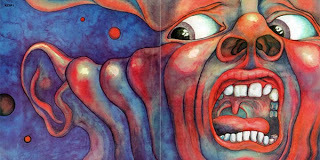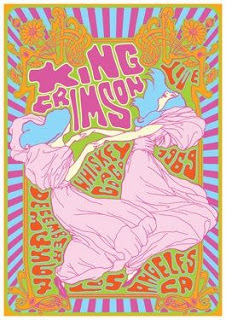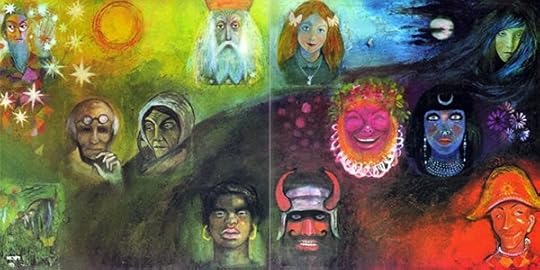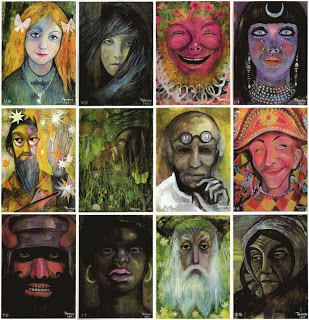Tomorrow and Tomorrow and Tomorrow, Creeps in this petty pace from day to day...
 ...And so it was for rock 'n' roll in the mid-60s: malingering, strolling casually down Tin Pan Alley. In '65 we'd gone wild with Freddie and the Dreamers and Herman's Hermits (let your freak flag fly!), and then, bam, like a supernova, a bi-polar onslaught of MC5 and Moby Grape, of 13th Floor Elevators and Zombies. Out of this schizoid cavalcade came King Crimson like lab-quality LSD25, and despite the advent of metal and psychedelia, the critics were left to ponder, "Where the fuck did that come from?"
...And so it was for rock 'n' roll in the mid-60s: malingering, strolling casually down Tin Pan Alley. In '65 we'd gone wild with Freddie and the Dreamers and Herman's Hermits (let your freak flag fly!), and then, bam, like a supernova, a bi-polar onslaught of MC5 and Moby Grape, of 13th Floor Elevators and Zombies. Out of this schizoid cavalcade came King Crimson like lab-quality LSD25, and despite the advent of metal and psychedelia, the critics were left to ponder, "Where the fuck did that come from?" King Crimson formed in 1968 with former band members of Giles, Giles and Fripp: Robert Fripp (guitar), Michael Giles (drums) and Peter Giles (bass), plus Greg Lake (vocals), Ian McDonald (winds, vibes) and Pete Sinfield (lyrics and light show). From its formative years in Bournemouth, England, King Crimson's guiding force has constantly been Fripp who attributes the band's longevity to the "collective brilliance of its individual members." Fripp bfirst picked up the guitar at the age of eleven. By 18 he was playing bar-mitzvahs and weddings with a band in Bournemouth. While early influences included Bartok and Debussy and Django Reinhardt and Hendrix, Fripp was particularly drawn to The Beatles' "A Day In The Life," which he claimed affected him in the same manner as classical compositions and free form jazz. The Cheerful Insanity of Giles Giles & Fripp was released on Deram Records in September 1968. Despite the humorous folky musings and jazzy guitar riffs by Fripp, sales were dismal. It was then that Fripp and the Giles brothers evolved into King Crimson; playing their first gig at London's Speakeasy in April '69. The following week the band began a three month Sunday residency at the Marquee Club, overwhelming London's already avant-garde music scene with an impressive mix of rock, jazz and classical music. The acid test was Crimson's performance at The Rolling Stones' free concert in Hyde Park in front of half a million of London's hippest folks. KC's impact was immeasurable, with Jimi Hendrix shaking Fripp's hand and heavy hitting record companies vying for contracts, with Island Records in the UK and Atlantic in North America emerging as victors.

King Crimson's legendary debut album, In the Court of the Crimson King, remains the most influential progressive album in rock history and one of the most innovative and creative works ever recorded. Pete Townsend of The Who described it as an "uncanny masterpiece." Adorned with ominous neo-gothic gatefold artwork by Barry Godber, a friend of Pete Sinfield's, it would become one of the most recognizable LP covers. Tragically Godber would die of a heart attack in February of 1970 at the age of 24. The music, with its portentous lyrics, spacious Mellotron passages and futuristic angular guitar lines had a dark, orchestral sound. Tranquil ethereal atmospheres with baroque touches were interspersed with dramatic crescendos and psychotic be-bop, particularly on opening track, "21st Century Schizoid Man," highlighting the band's musical prowess. The piece would become the band's trademark over the next few years and conjured up enough doom, gloom and confusion to rival any prototypical metal band of the day. In November 1969, In The Court Of The Crimson King hit number 5 in the UK and the band embarked on a tour of the United States to support its release on Atlantic Records. The 20 gig tour opened at Goddard College in Vermont and included Boston, Detroit, New York, Palm Beach, a sold out five night stint at the Whiskey-a-Go-Go and three nights at the Fillmore.
 In the Court of the Crimson King
(AM9)
In the Court of the Crimson King
(AM9) Artist: King Crimson
Producer: KC
Length: 43:53
Released: October 10, 1969
Tracks: 1) 21st Century Schizoid Man (7:24) 2) I Talk to the Wind (6:04) 3) Epitaph (8:49); 4) Moonchild (12:13) 5) The Court of the Crimson King (9:26)
Personnel: Bass, Lead Vocals – Greg Lake; Drums, Percussion, Vocals – Michael Giles; Guitar – Robert Fripp; Keyboards, Mellotron, Woodwind, Vibraphone, Reeds – Ian McDonald; Lyrics, Other [Illumination] – Peter Sinfield
In the Court of the Crimson King is powerfully dark, unwaveringly ambitious, and fearlessly experimental. The much-maligned Mellotron was never utilized as deftly before or since, nor have tender balladry, symphonic dirge and ferocious jazz-metal worked so well together on any other album. The overwhelming power of "21st Century Schizoid Man" took 1969 by surprise, and its instrumental ferocity, compositional obliquity and KC’s stunning musical chops – Fripp's roaring guitar, McDonald's piercing sax, Giles' drum demolishment and Lake's unsubmissive bass and ghostly vocals – are still capable of making 1st time listeners drool, or they should. It's kind of like reading Shakespeare, you get revelation after revelation: "Wow, that's where it first came from." In the Court of the Crimson King takes every stereotype and joke about prog rock and confounds, defies, and destroys them. Doesn't rock hard enough? Bollocks. Aimless? If only all rock albums were this focused. Too pretentious? That's pretty much this album's greatest strength - without that pretention and ambition, it wouldn't have been such a seismic release. In the Court of the Crimson King owns its hefty reputation because it's brilliant. It's a-okay here to be Catherine Obvious; it's honestly as simple as that. "Epitaph" is one of man's greatest musical achievements (maybe that's the booze talking). Still, based on its feet-wet experimentation and an inability to edit itself, the Crimson King is but an AM9.
 Live at the Whiskey-a-Go-GoDespite the enthusiastic reception the band received in America, Michael Giles and Ian McDonald quit the band citing the rigors of touring and Fripp's heavy-handedness. This development left the future of King Crimson in doubt amidst rumors that Fripp was going to replace Peter Banks in Yes. Greg Lake also had reservations and had discussed the possibility of forming a band with Keith Emerson (the two met backstage at the Fillmore in San Francisco). Nonetheless, Lake stayed aboard long enough for the 2nd outing. Over the next few months other musicians were recruited as "guests," most notably jazz pianist, Keith Tippett and session man, Mel Collins, on woodwinds, with Peter Giles returning to lay down bass. In March 1970 a crazed, left of center single was released entitled "Cat Food," on which Tippett's jazz finagling combined with Lake's evocative vocals culling one of the most extreme singles ever to hit the airwaves. In The Wake Of Poseidon followed in May sounding notoriously like its predecessor with neo-classical styling, sweeping Mellotrons (now formidably handled by Fripp) as well as a "21st Century Schizoid Man" doppelganger, "Pictures Of A City."
Live at the Whiskey-a-Go-GoDespite the enthusiastic reception the band received in America, Michael Giles and Ian McDonald quit the band citing the rigors of touring and Fripp's heavy-handedness. This development left the future of King Crimson in doubt amidst rumors that Fripp was going to replace Peter Banks in Yes. Greg Lake also had reservations and had discussed the possibility of forming a band with Keith Emerson (the two met backstage at the Fillmore in San Francisco). Nonetheless, Lake stayed aboard long enough for the 2nd outing. Over the next few months other musicians were recruited as "guests," most notably jazz pianist, Keith Tippett and session man, Mel Collins, on woodwinds, with Peter Giles returning to lay down bass. In March 1970 a crazed, left of center single was released entitled "Cat Food," on which Tippett's jazz finagling combined with Lake's evocative vocals culling one of the most extreme singles ever to hit the airwaves. In The Wake Of Poseidon followed in May sounding notoriously like its predecessor with neo-classical styling, sweeping Mellotrons (now formidably handled by Fripp) as well as a "21st Century Schizoid Man" doppelganger, "Pictures Of A City." In the Wake of Poseidon
(AM8)
In the Wake of Poseidon
(AM8) Artist: King Crimson
Producer: Fripp, Sinfield
Length: 41:02
Released: May 15, 1970
Tracks: 1) Peace, A Beginning (:51) 2) Pictures of a City (7:57) 3) Cadence and Cascade (4:35); 4) In the Wake of Poseidon (8:24) 5) Peace, A Theme (1:15) 6) Cat Food (4:52) 7) The Devil's Triangle (11:30); 8) Peace, An End (1:54)
Personnel: Lead Vocals (except 3) - Greg Lake; Drums, Percussion, Vocals - Michael Giles; Guitar, Celesta, Mellotron - Robert Fripp; Woodwinds, Flute - Mel Collins; Words, Production - Pete Sinfield; Bass - Peter Giles; Piano - Keith Tippet
 On a personal note, if I'd heard In the Court of the Crimson King before In the Wake of Poseidon, who knows what would have been the outcome? Here the AM rubric fails a bit. This was exciting stuff; certainly it was exciting to me. It was '74 by the time I'd picked up KC, thoroughly immersed in Yes and Tull, and singing like Jon Anderson in a high school band. But Poseidon raised the bar. In retrospect there's an obvious link between the first two Crimson albums, the first serving as template; however, Fripp & Co. set out to make an even more advanced album in the second round, despite the break-up of the band; Poseidon shouldn't even have happened.
On a personal note, if I'd heard In the Court of the Crimson King before In the Wake of Poseidon, who knows what would have been the outcome? Here the AM rubric fails a bit. This was exciting stuff; certainly it was exciting to me. It was '74 by the time I'd picked up KC, thoroughly immersed in Yes and Tull, and singing like Jon Anderson in a high school band. But Poseidon raised the bar. In retrospect there's an obvious link between the first two Crimson albums, the first serving as template; however, Fripp & Co. set out to make an even more advanced album in the second round, despite the break-up of the band; Poseidon shouldn't even have happened. The opening, "Peace - A Beginning," has Lake in an enigmatic cavern, chanting an ethereal pastiche. "Pictures of a City" crashes in like thinking man's metal with medieval nodes and a jazz structure far more sophisticated than anything on Court. The piece does indeed bear a strong relation to "21st Century Schizoid Man," but a clone? No way. Nothing as complex and demanding as this could be seen as part of a formula. "Cadence & Cascade" as "I Talk to the Wind 2.0?" Again, nearly, yet more sophisticated. This is an adult ballad, a summery-yet-melancholy love-song. Beautiful. The title track has echoes of "Epitaph" but its lyrical cleverness lends it credibility. The rest of the album holds its own, moves on, exemplifies: "Peace (A Theme)" shows just how good Fripp was as an acoustic minstrel; the hilarious and jazzy "Cat Food" is "Moonchild" plus; and "Peace (An End)" wraps it up in emotive style. "Peace is the end, like death of the war" - lump in throat time. Advice: listen to Wake as if Court didn't exist. It's the better of the two and yet an AM8 (the rubric and the rules to blame).
The composite above reflects the 12 Faces of Humankind (from left to right): The Child (Water and Air): A picture of innocence; a girl with a delicate sweet smile and butterfly-shaped bows at each side in her long golden hair. She wears a gold chain, on the end of which is a small golden key. The Enchantress (Water and Earth): A sad girl with watery eyes; The Fool (Fire and Water): A laughing man with a wispy beard. The Actress (Water and Fire): An Egyptian girl with long pearl earrings and many pearl necklaces around her neck, she has tears in her eyes; The Logician (Air and Fire): A scientist or wizard with a long face, dark hair and long dark holding a wand with his right hand and his left is held aloft and surrounded by stars. Mother Nature (Earth and Water): Lying asleep in the long grass; The Observer (Air and Earth): A scientist with round spectacles pushed up above his brow; The Joker (Fire and Air): A smiling twinkle-eyed Harlequin with his typical gold motley crew. The Warrior (Fire and Earth): A dark and powerful warrior in blacks and reds; The Slave (Earth and Fire): An African woman with large gold earrings and a ring through her nose, her expression is warm and friendly; The Patriarch (Air and Water): An old philosopher, with a long face and long white hair and long white beard; The Old Woman (Earth and Air): A woman with much wrinkled face wrapped up against the cold.
Published on September 29, 2020 05:15
No comments have been added yet.



